All Souls Church Pods in Bolton, Lancashire Interior, Architect, Design, Architecture, Images
All Souls Church Pods
Place of Worship Interior in Lancashire, England, UK – design by OMI Architects
26 Nov 2014
All Souls Church Pods in Bolton
Location: Bolton, north west England
Design: OMI Architects
All Souls Church in Bolton
Address: 2 Charlotte St, Bolton BL1 3QG
Phone: 01204 385868
Original Building Opening: 1881
Architectural style: Gothic Revival architecture
Architect: Sharpe, Paley and Austin
FUTURISTIC PODS INSIDE CHURCH ARE A HOMAGE TO ITS HERITAGE
Arresting Conversion of Listed Vi CHURCH COMPLETED
The new look modern interior to a Grade II* listed church in Bolton will be unveiled to the public on 6th December. It follows a £4.9m adaptive reuse project, which has been ten years in the making. The regeneration project recently won an English Heritage Angel Award for The Best Rescue of Any Other Type of Historic Building or Site.
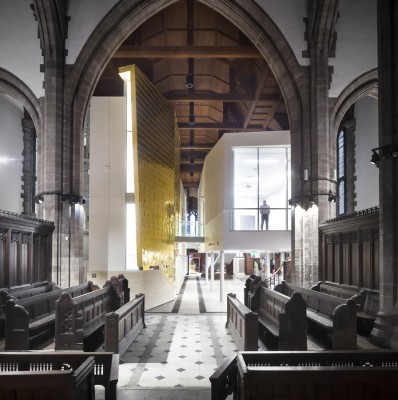
Two futuristic free-standing ‘building within a building’ structures have been erected inside the church. These ‘pods’ will house a coffee shop and restaurant, meeting and event spaces, and be a centre for heritage learning. Pod 1 is a three story 10.5m high structure on the south side of the nave. It comprises offices and a kitchen on the ground floor, a production suite, meeting rooms and toilets on the first floor, and classrooms on the second floor. Pod 2, on the north side, has a single large events space/conference room on the first floor, which is raised up on six columns to accommodate an “open air” coffee shop and restaurant within the nave of the church on the ground floor.
According to Manchester firm OMI Architects, who masterminded the project, the apparently organic form has connections with both the original church interior and its urban context. All Souls was built at the junction of two terraced streets, an attempt to make the community church visible and prominent. Although the local street configuration has changed over the church’s 130 year existence, the church’s sleek new pods will serve as a reminder of the church’s heritage: contrasting the geometry of the urban grain with the church’s rectilinear plan form.
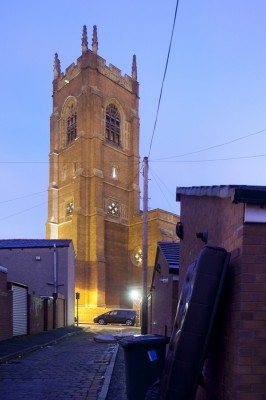
Constructed over a period of just over a year, all materials and machinery were brought in and out through the church’s two-metre wide west doorway. This limitation resulted in the use of prefabricated SIPS panel construction, limiting the need for heavy lifting equipment during construction.
Consistent with the project’s commitment to the church’s unique 19th century architecture, this ‘ship in a bottle’ project brings modern architecture into a heritage setting without compromising the historic fabric of the church. The new buildings are set back from the exterior walls of the church to enable an appreciation of the finely constructed panelled roof and an entirely unobstructed view of the church’s east end – a design made possible thanks to the unique monolithic single span space of the original church.
For the first time ever, visitors will be able to get up and close with the church’s historic features via a high level open deck circulation system, designed to celebrate the church’s architectural features. As well as adding much needed amenity space within the building, the new design’s stairways and raised walkways take visitors on a journey around the historic building, allowing visitors to get much closer views of the windows, war memorials and unique timber roof.
The Churches Conservation Trust is hoping that the award-winning design of All Souls with its multi-purpose community use, will become a national model for the 200 inner city churches at risk (English Heritage at Risk Register 2014)
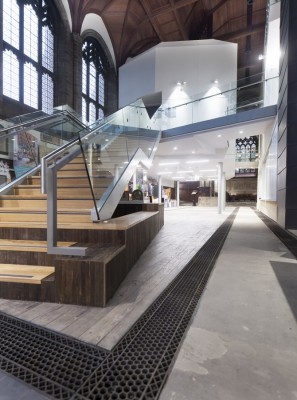
Nick Berry, OMI Architects, said:
“Respect for the original design of the church and its urban context has been key to the inspiration for the new design, but also the strongly held view that the new interventions should not be subservient to surrounding architecture. The unusually wide 16m single span of the nave has allowed for the insertion of relatively free form buildings, but instead of mirroring the historic fabric of the church, we have based our design on the concept of ‘contrast’. Whilst the new architecture is deliberately different from that of its host, the dialogue between the two serves to amplify the architectural qualities of both. It’s a voyage of discovery as you move through the building reading different elements of the existing architecture against the backdrop of the new.”
Crispin Truman, Chief Executive of The Churches Conservation Trust, said: “Urban churches like All Souls pose a particular challenge, as their size makes repairs expensive and finding sustainable new uses tricky. But when such important historic buildings sit unused and at risk we have a duty not only to save them, but also to help local people make use of them. This arresting and dramatic new design enables All Souls to be used in new ways and it demonstrates not only how to enable new uses of a Grade II* church whilst maintaining its heritage, but also how enrich the lives of those who live around such buildings. Forget the ‘Bilbao Effect’ as a byword for ‘wow-factor’ architecture, future generations will be talking about the ‘Bolton Model’ for the regeneration of unloved urban churches.”
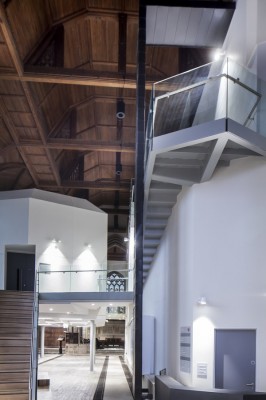
The project should give the building another 100 years of life, transforming it from unloved 19th century church into a state-of-the-art community building for people of all faiths or none.
Throughout the construction programme, The National Heritage Training Group funded six paid training placements to economically disadvantaged Bolton residents, on top of a series of weekly technical days for locals which focused on key heritage conservation skills.
This unique project is the latest innovative conservation scheme from The Churches Conservation Trust to provide a sustainable use to historic churches, with others including the conversion of St Paul’s Church, Bristol into a circus school. Next in line for the CCT is the transformation of St Mary at the Quay, Ipswich into a wellbeing heritage centre, opening in early 2016.
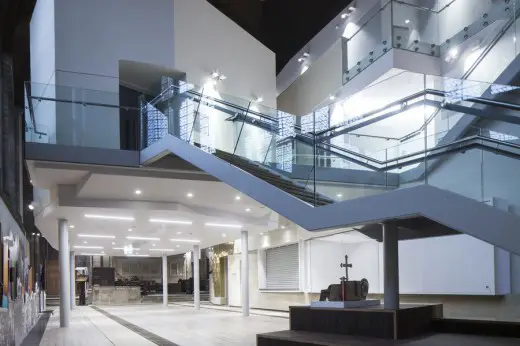
All Souls Church Pods in Bolton – Building Information
• £4.9m award-wining adaptive reuse project of All Souls church in Bolton completed
• New interior structure features two futuristic pods linked to ‘urban grain’
• High walkways offer close-up views of stained glass, war memorials and timber roof
• The Churches Conservation Trust has developed a national model for England’s 200 urban churches at risk
• Official opening takes place on 6th December 2014
Photographs: Andy Marshall
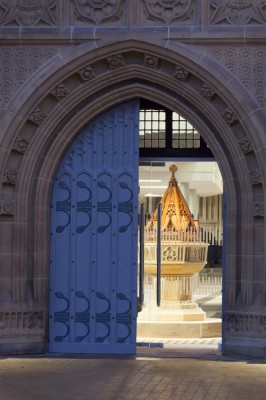
All Souls Church Pods in Bolton images / information from Faulknerbrowns, Architects
Location: 2 Charlotte St, Bolton, BL1 3QG, Northwest England, UK
Northwest English Architecture
Contemporary Lancashire Buildings
Make Architects
Gary Neville House
Charles Carter Building, Lancaster University, north Lancashire
John McAslan + Partners
Charles Carter Building
Manchester Architecture Walking Tours
Rochdale Road building on e-architect: Skyline Central
Exchange Court Greengate: Residential Building Salford
Design: OMI Architects
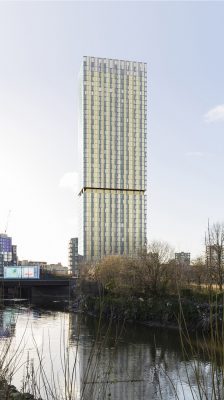
image from architect
Website : OMI Architects
Comments / photos for the All Souls Church Pods in Bolton page welcome
Website : All Souls Church Bolton


